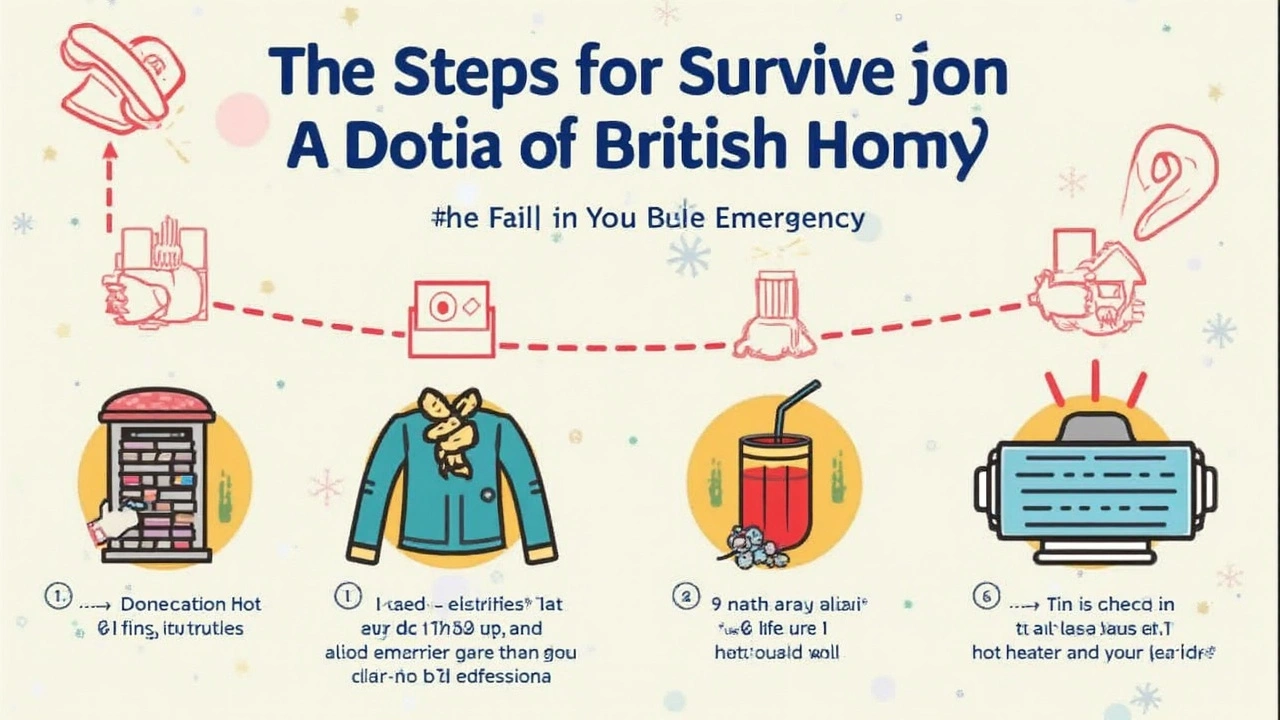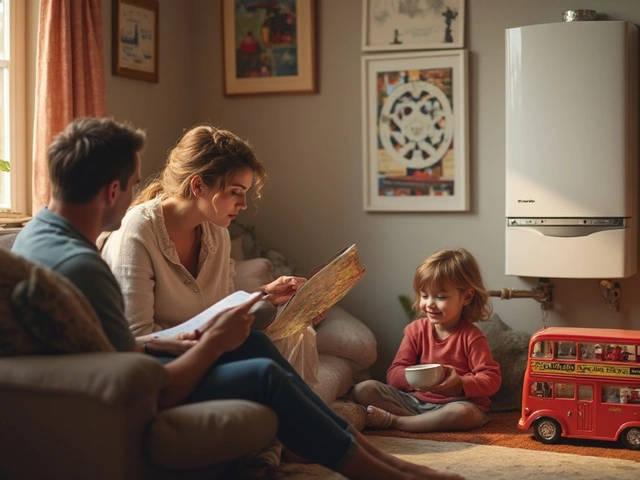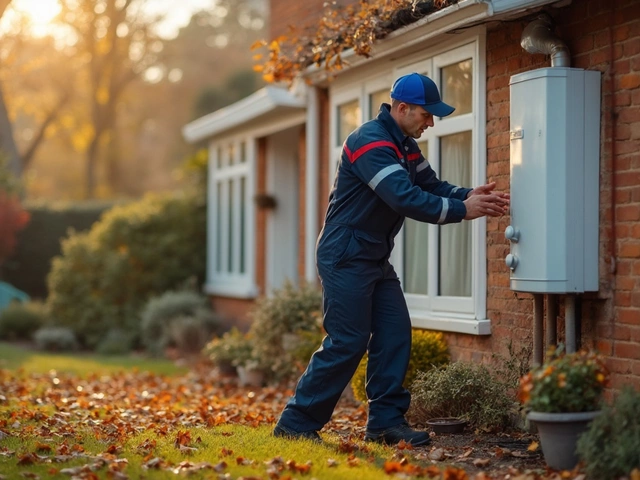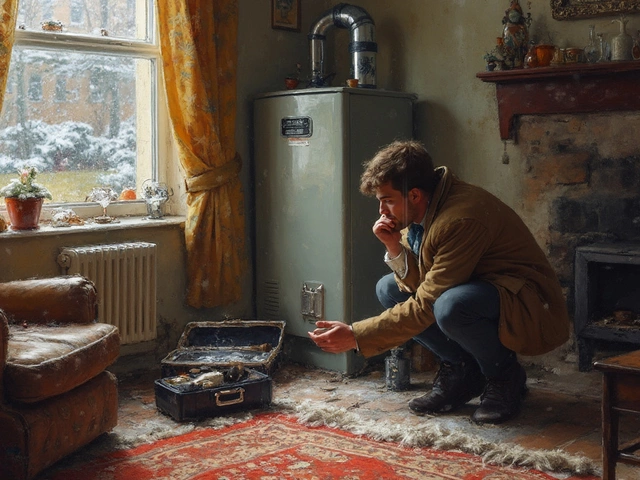Your boiler’s quit, it’s freezing, and now your living room’s starting to feel like a walk-in fridge. Don’t panic—plenty of folks have been here, and you’ve got options. First things first: plug in any electric space heaters you have. Stick them in the rooms you use the most. Shut the doors to hold the heat in. If you have an oil-filled radiator, this is its time to shine.
Layer up—grab those thick socks, sweaters, and even a hat if it gets really chilly. Blankets aren’t just for bedtime; use them while you sit around too. Collect everyone in one room if you can, since it’s easier to keep one place warm than the whole house. And if you bake or cook on the stove, leave the kitchen door open after you’re done to let that precious warmth drift through.
- Quick Heat Fixes You Can Use Now
- Safe Alternatives to Central Heating
- Tips for Keeping the Warmth In
- What NOT to Do When Heating Without a Boiler
- Getting Your Boiler Fixed—And Ready for Next Time
Quick Heat Fixes You Can Use Now
If your boiler suddenly stops working, you need fast solutions to avoid turning your home into an icebox. The most practical move is to use what you already own—that means plugging in electric heaters or oil radiators. These can warm up spaces quickly, especially if you close off unused rooms to trap the heat where you need it most. Fun fact: a standard 1500-watt space heater can heat a small room of about 150 square feet by at least 10°F within an hour, depending on insulation and outside temperature.
Don’t overlook your oven and stove, but never use them as the main heat source for safety reasons. Instead, after you’ve cooked, leave the oven door slightly cracked so the heat drifts out—just be sure kids and pets stay clear. Kettles and boiling pots on the stove can also add a little warmth and humidity.
If you’ve got heated blankets or electric throws, break them out. They cost much less to run than heating an entire room and they give instant results. Get everyone together in the warmest room, close the doors, and cover windows with thick curtains or blankets to slow down the heat loss. Even simple things like rolling up towels and blocking draughts under doors make a noticeable difference.
- Plug in space heaters or oil radiators, one per room for safety
- Gather people in a single room to trap body heat
- Use thick curtains and towels to block door and window drafts
- Layer up with extra clothing, hats, wool socks, and blankets
- Keep moving—do a few jumping jacks every so often to get your blood flowing
Here’s a quick look at what works best for fast warmth:
| Heat Source | Approximate Heat Output | Area Heated |
|---|---|---|
| Electric Space Heater (1500W) | ~5000 BTU/hr | Up to 150 sq ft |
| Oil Radiator (1500W) | ~5100 BTU/hr | Up to 150 sq ft |
| Heated Blanket | Body-scale | Direct/local warmth |
| Hot Water Bottles | Local warmth | Hands/feet/bed |
All these moves can help you keep your home comfortable while you wait for boiler repair or a full fix.
Safe Alternatives to Central Heating
If your regular heating system is out of action, you need to know what actually works to keep you warm and what’s just wishful thinking. The first go-to for most people is the portable electric space heater. These come in all shapes and sizes, from simple fan heaters to oil-filled radiators. Plug them in, stick them where you need the warmth most, and always keep them away from curtains or anything flammable for safety. Don’t overload sockets—one heater per outlet keeps things safe.
Another good pick: heated blankets or electric throws. You’ll use a lot less electricity than you would trying to heat a whole room, and it’s a good way to stay cozy, especially if you’re sitting still for a while. Set the timer if your blanket has one, so you’re not running it all night.
If you have a fireplace—real or electric—this is its moment. Just be sure your *chimney is clean* before lighting up a wood or coal fire. Never leave an open flame unattended, and keep a window cracked to avoid carbon monoxide buildup if burning real fuel.
For those with a gas stove or oven, don’t try to use it for heating your house. It’s not built for that and it’s a big safety risk. Stick to cooking, then let the heat drift into other rooms after you’re done. Never leave the oven door open to heat your kitchen—it’s a known source of accidents and can create dangerous air inside.
Of course, don’t forget about old-school wool blankets, hot water bottles, and even those microwaveable heat packs. They don’t use any power at all and can provide a surprising amount of warmth. Double up on layers, grab extra socks, and use thick rugs on bare floors—they keep the warmth from escaping through your feet.
Even in a pinch, stay smart about safety. If you’re trying something new to warm your place, always follow the instructions and never leave any heat source on when you leave the room or go to bed. And if you’re not sure a device is safe, don’t risk it—ask someone who knows or err on the side of caution. Your safety is always more important than a quick fix.
If you need quick help or advice, call a local boiler repair company for emergency guidance. Don’t try anything questionable—there are safe, solid choices for staying warm while you’re waiting for real repairs.

Tips for Keeping the Warmth In
If you’re dealing with a broken boiler, every bit of heat you can trap really counts. It might surprise you how much you can do without fancy gadgets. Most heat loss happens through windows, doors, and even floors, so here’s how to fight back:
- Block out drafts: Roll up towels or old clothes and push them against the bottoms of doors. Draft excluders work even better if you have them. Don’t forget letterboxes and keyholes—heat loves to escape through the tiniest gaps.
- Use curtains wisely: Thick curtains or blankets over windows make a massive difference. Open them during sunny winter days to steal a little heat from the sun, then shut them as soon as it starts to get dark.
- Move furniture off cold walls: Sofas and beds pushed up against outside walls can get chilly fast. Pull them a few inches away if you can—a tiny gap helps more warm air circulate.
- Layer up floors: Throw rugs or extra mats down on bare floors. Floorboards let cold air sneak up, but adding a few layers can stop a lot of heat loss.
- Stick together: Get everyone in one room. Bodies give off heat, and a group is easier (and cheaper) to keep warm than spreading out over the house.
Check out the numbers—most UK homes lose heat like this:
| Where Heat Escapes | Percent of Total Loss |
|---|---|
| Walls | 33% |
| Roof | 26% |
| Windows | 18% |
| Floors | 15% |
| Drafts (gaps around doors/fittings) | 8% |
If you’re in an older house or a place with single-glazed windows, you’ll probably feel that chill even more. Bubble wrap stuck to the insides of windows actually works in a pinch—it cuts down on heat loss and costs almost nothing. The main thing? Don’t let that hard-earned warmth drift away. Even these cheap tricks can shave a degree or two off a freezing night indoors.
What NOT to Do When Heating Without a Boiler
When your broken boiler leaves you in the cold, it’s tempting to try anything for a little more heat. But some methods are flat-out dangerous or just cost way more than they’re worth. Let’s get real about what you should never try.
- Never use your gas stove or oven for heat. It’s not built to warm your house, and it can fill your home with carbon monoxide—an invisible, deadly gas. The CDC reports that over 400 people die in the U.S. each year from accidental CO poisoning, often from using household appliances the wrong way.
- No charcoal grills indoors, ever. Charcoal gives off carbon monoxide too. Even a cracked window isn’t enough to make this one safe.
- Forget about open fires unless you have a certified, well-maintained fireplace or wood stove. Otherwise, you risk fires or—you guessed it—CO poisoning.
- Don’t overload outlets with too many space heaters. Modern heaters will trip a breaker, but old wiring could overheat and start a fire. Stick to one heater per room and never use a frayed cord.
- Skip DIY electric fixes on your boiler. Unless you’re licensed, you could make the problem far worse—and way more expensive to fix.
If you’re curious about just how risky some heating hacks really are, check out these numbers:
| Unsafe Heating Method | Risks | Reported Annual Accidents (US) |
|---|---|---|
| Oven as heater | CO poisoning, fire | 100+ injuries |
| Charcoal grill indoors | CO poisoning, fire | 70+ injuries |
| Overloaded outlets | Electrical fire | 24,000+ home fires |
Bottom line: stick to approved, safe heat sources while you wait for the professionals. Saving a few bucks isn’t worth risking your family’s health or your house.

Getting Your Boiler Fixed—And Ready for Next Time
If your broken boiler is just sitting there making your teeth chatter, you’re probably itching to get it sorted. Here’s what works: call a qualified heating engineer. Don’t try to fix a modern boiler yourself, since you can void your warranty and it’s honestly just risky (gas leaks are nothing to mess with). You can usually find certified local pros through TrustMark or Gas Safe Register—just make sure anyone you hire is legit and listed. Most boiler callout times average around 24 hours in winter, but it can stretch to days if there’s a cold snap.
If you want to help them work faster, give them as much info as you can: boiler make and model, what noises you’ve heard, any strange lights or error codes. That way, they show up prepared and you’ll save everybody time.
- Don’t forget to check if your boiler is still under warranty—some parts and labor could be free.
- Ask your heating engineer for a brief breakdown of what went wrong and if something could have prevented it.
- Record the repair in a notebook or keep the invoice—it can help when selling your house or facing repeat issues.
Now, if you want to avoid another freezing night, think ahead. Set reminders for annual servicing—most experts agree a yearly boiler check cuts down breakdown risks by up to 50%. If your boiler is old (10+ years), start budgeting for a new one. Modern boilers aren’t just more reliable; they’re crazy efficient and government grants sometimes help with the costs.
Just look at this:
| Boiler Age | Efficiency | Breakdown Risk |
|---|---|---|
| 1-5 years | 92-95% | Low |
| 6-10 years | 85-89% | Medium |
| 11+ years | 74-80% | High |
Besides yearly servicing, keep the area around your boiler clear, bleed your radiators once a year, and make sure the pressure stays in the recommended range—usually between 1.0 and 1.5 bar. Keep the number of a trusted heating engineer handy. The reality is, every boiler breaks at some point. Being prepared is all about saving yourself the hassle next time.




